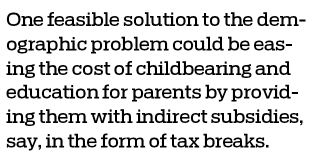High cost of raising children behind low birth rate

This year marks the fifth anniversary of the introduction of the new family planning policy that encourages all couples to have two children so as to raise the birth rate to cope with rapid aging population problem.
At a time when China is undergoing tremendous demographic changes, the family planning policy has acquired added significance. Looking back, the implementation of the family planning policy since 2010 can be divided into three parts.
First, since 2010 many provinces and regions have dropped the precondition that a family needs to have a second child years after the first, and thus helped increase the number of births from 15.92 million in 2010 to 16.40 million in 2013.
Second, in 2013 China gave the green light to couples one of whom was the only child of his or her parents to have two children. But despite that, the number of births declined from 16.87 million in 2014 to 16.55 million in 2015.
And third, after the easing of the family planning policy in 2016 allowing all couples to have two children, the number of new births rose briefly to 17.86 million, the highest since 2000. But the number has fallen every year since. And the decline in the number of births continued during the 13th Five-Year Plan (2016-20) period.
Therefore the decision to allow all couples to have two children played a limited role in increasing the overall fertility rate. According to official data, the two-child policy helped push the fertility rate, or the average number of children a woman gives births to, from 1.05 in 2015 to above 1.5 in 2016 and 2017, but the rate dropped to 1.49 in 2018 and further to 1.47 in 2019, compared with the average fertility rate of 1.65 from 2006 to 2015.
The actual number of births declined from 2018 to 2019, but the fertility rate remained stable because of the declining number of women of childbearing age. In fact, China's population is likely to enter negative growth territory sometime between 2025 and 2030.
Negative population growth and aging population have an inextricable relationship. And due to the declining birth rate and increasing life expectancy, China will face an accelerating aging population problem in the future.
Efforts to boost the fertility rate to optimize the demographic structure have long-term impacts on society, although the family planning policy introduced in 2016 has shown that it is not possible to solve the aging society problem by trying to boost the fertility rate as fewer couples tend to have two children.
Further, even if the birth rate increases, it cannot fundamentally ameliorate the effects of the graying population. The number of newborns today can, if only partly, offset the aging population problem at least a couple of decades later. Therefore, the government should not try to address the aging problem by only boosting the fertility rate. Rather, it should focus more on boosting economic and technological development.
Also, there is a need to differentiate between the problems of aging population and elderly people. The former is rooted in economic development while the latter is about people's well-being. To solve the problems of senior citizens is to help them enjoy the fruits of economic development by improving their living standards, especially as advanced technologies have created opportunities for senior citizens to participate in various social activities.
Many misunderstand the relationship among a low birth rate, aging population and negative population growth. The decline in the population is inevitable even if the family planning policy is further relaxed, simply because couples are unwilling to have two children-with some preferring to not have any child-not because of the policy, but because of the problems associated with raising a child.
Several polls have shown the four main reasons why couples are reluctant to have two children are the high cost of raising kids, a lack of nursery facilities, an increasingly later age of women giving birth and the imbalance between childcare duties and career development.
One feasible solution to the demographic problem could be easing the cost of childbearing and education for parents by providing them with indirect subsidies, say, in the form of tax breaks.
Besides, the authorities are pushing forward a comprehensive package of pro-family measures that cover marriage, fertility, education, housing, eldercare and social insurance, and taking into consideration gender equality and trying to strike a balance between childcare duties and career development, and give families bigger say in their own family planning.
The author is a professor at the Institute of Population and Development, Nankai University.
The views don't necessarily reflect those of China Daily.





















